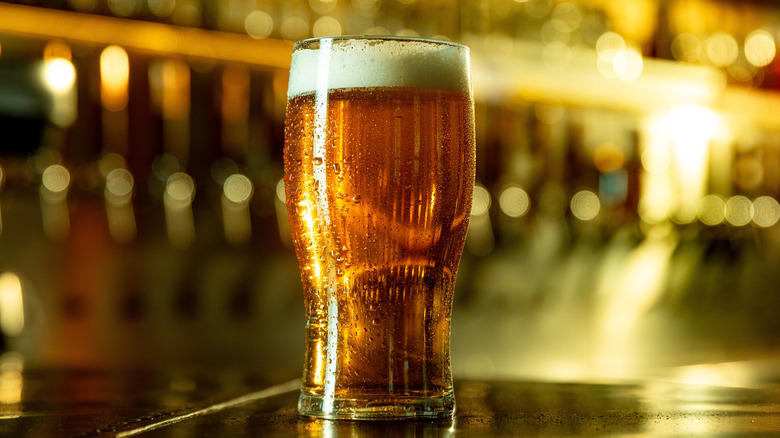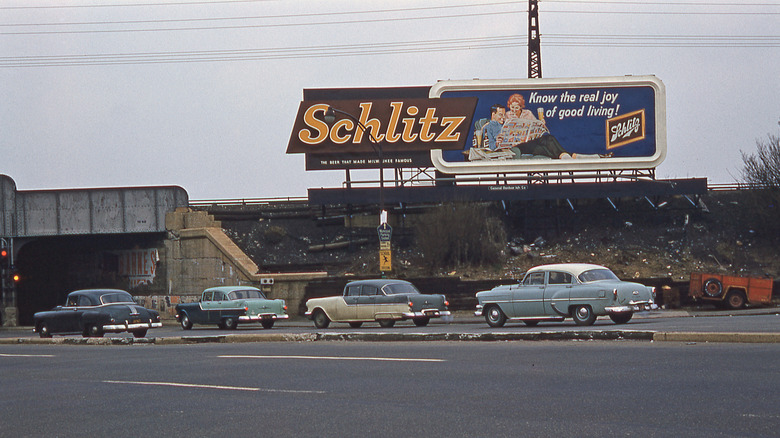America's Former Top Selling Beer Is Now Almost Impossible To Find
If asked to name America's top-selling beer, Budweiser or Coors would be a fair guess (Fact: In 2025, Michelob Ultra is now the top-selling beer by volume). But before any of these brands had a strong foothold in America, in the mid-20th century, you would have been asking for a now-mostly-unheard-of beer: Schlitz. For a long period, Schlitz reigned supreme as one of America's top-selling beers.
First brewed in Milwaukee in 1849, Schlitz operated originally under the name Krug Brewery. The name was updated when Joseph Schlitz took over the business and married the founder's widow. Its slogan became "The Beer That Made Milwaukee Famous" by the 20th century, and the company would continue to use this line for decades.
Schlitz was a working-class beer, a consistent, clean-tasting, and uncomplicated lager. It was widely available and affordable, and at a low ABV, so it could be an anytime beer. Before the 1950s, it was the top-selling beer in the United States, beating out competitors like Pabst and Anheuser-Busch. Part of its success was timing, as beer was becoming mass-produced and advertising exploded, Schlitz capitalized on this. The company invested heavily in TV and billboard ads, and positioned itself as the beer of the everyman.
The Rise and Fall of Schlitz
By the late 1970s, Schlitz had begun to fall out of favor, and by the early 1980s, the company hit a sharp decline, leading to its eventual obscurity. It could be chalked up in part to rising competition from big breweries, but much of the fault can be placed on Schlitz itself.
Schlitz wanted to keep up with demand and maintain a competitive edge, all while maximizing profits. Rather than continue doing what it did best — making a solid, no-frills beer for the masses — it took a different approach to cheapen the cost of making its beer. They switched to cheaper ingredients, shortened the brewing time, and relied more on additives. Instead of malted barley, corn syrup was used, and hop pellets replaced fresh hops.
The strategy did seem to work momentarily, as Schlitz claimed in 1973 that it was one of the most efficient breweries in the world. Those who were longtime drinkers of Schlitz noticed the difference. The beer tasted different, and not in a good way, and the flavor wasn't consistent. There was also an unfortunate brewing mishap in the early '70s when a clarifying agent caused some batches to develop a snot-like mass floating on top, leading to a massive recall.
Schlitz's infamous advertising campaign
In the years after Schlitz changed its recipe, the company ran a now-infamous advertising campaign in 1977 that was essentially the nail in the coffin for the company. The campaign featured a variety of different "manly" men, like an outdoorsy one, a construction worker, and a boxer. The narrator offers these men the opportunity to switch out their Schlitz beer for another brand and each strongly declined, threatening physical confrontation and injuries for such a suggestion.
The public reception was so bad that the ad was actually pulled, but the damage to the brand perception was already done. Just a few years after holding the second most popular beer in America title, Schlitz closed its Milwaukee brewery in 1982. The brand passed through different hands, first acquired by the Stroh Brewery Company, and later it became part of Pabst Brewing. The beer brand made an unexpected reintroduction in 2008 with a different recipe that has a 68/100 (a "poor" score) on Beer Advocate.
Today, you can still find Schlitz in retro cans and branding, but not at the same volume as in the past, making it one of the vintage beers that (mostly) disappeared from American fridges.


